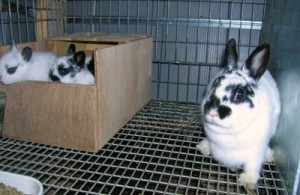Care of Nesting Boxes
by Laurie Stroupe.

Our procedure with nest boxes is to spray them off to remove any solid matter, hay, or fur. Then Andrew dunks them in a solution of bleach and water. He leaves them in there about ten minutes to soak them well. After that, he rinses them thoroughly and allows them to dry in the sun, weather permitting.
Our nest boxes are mostly plywood. I have some newer ones made of dimensional lumber. So far, this method has worked very well for us.
But there was a day when I needed a nest box in a hurry. There was no time for dipping and spraying and drying. So I took one that a doe had used. But she had missed, so the box looked clean.
Big mistake.
That was the only time I’ve ever had a doe to develop mastitis. And my vet said it was the worst case he’d ever seen. Boy, did I feel guilty. She had to be lanced in two places and I had to treat her twice a day by placing medication inside the cavities created. It was awful for both of us.
Now it’s true that it could have been a coincidence. I just know that if it ever happens again, it won’t be because the nest box was not sanitized in between.
Now if I have an emergency, which happens from time to time, especially when my show schedule is hectic, I may take a clean-looking nest box and spray it with a solution of Vanodine. So far, that has worked well, too.
Besides problems with a dam, who is scraping the nest box each time she jumps in and out, bacteria, fungus, or viruses could infect newborns causing the unexplained loss of the litter. It’s just not worth the risk.
Furthermore, a temperamental doe may not like the smell of a previous litter on her nest. Most of my does seem to tolerate the smells of other does pretty well. But there are a few who are very particular.
So, make it a habit of sanitizing your nest boxes between uses. It’s a bit of a hassle, but not nearly so much as dealing with an ailing doe or losing litters that need not be lost.

